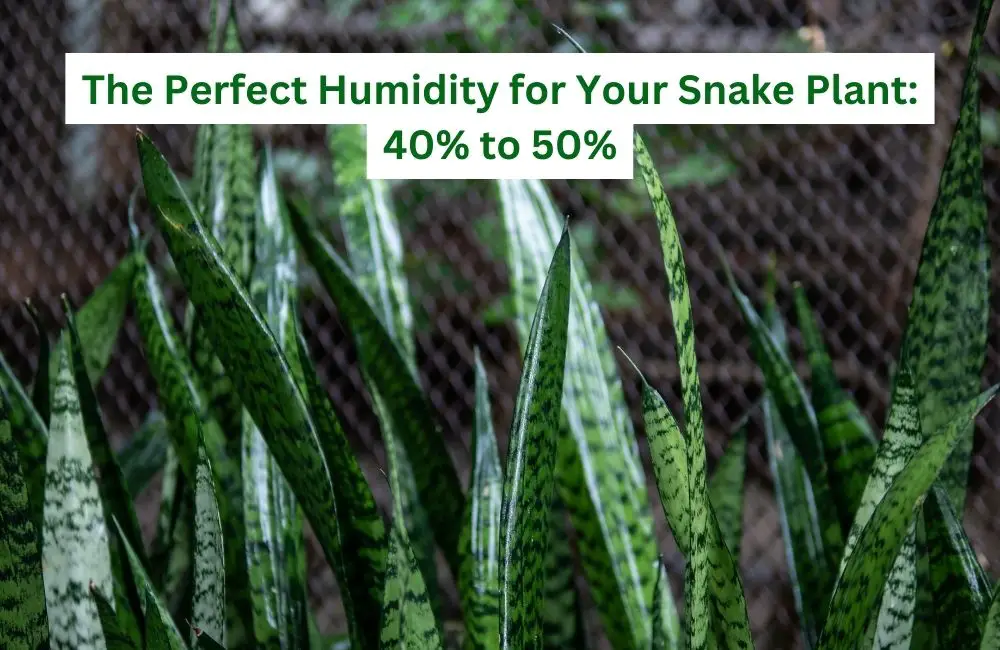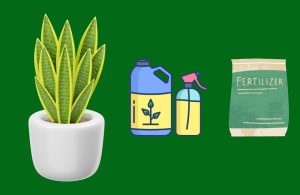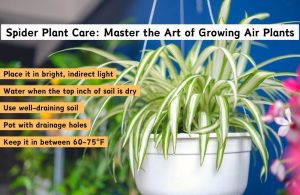This article covers the following areas –
- Understanding Humidity Needs for Snake Plants
- Simple Ways to Increase Humidity
- How to Avoid Excess Humidity
- Final Thoughts
- Frequently Asked Questions
Snake plants, known as Sansevieria or Mother-in-Law’s Tongue, are among the most popular and hardy indoor plants. They’re loved for their striking, upright leaves and ability to thrive with minimal care. Today, I will discuss the ideal humidity levels for snake plants and how to maintain them in your home.
The perfect humidity level for snake plants is between 40% to 50%. This range supports their health and prevents leaf browning. Snake plants can adapt to lower humidity, but maintaining this ideal range helps ensure they stay robust and vibrant.
Keep reading to discover practical tips on how to maintain this ideal humidity level for your snake plant, including simple methods to increase or decrease moisture in the air around your plant, ensuring it thrives in your home environment.
Understanding Humidity Needs for Snake Plants
Snake plants are remarkably resilient and originate from arid climates in Africa, where humidity levels are typically low. This adaptation allows them to thrive in environments that might stress other plants, making them popular for indoor settings.
Despite their hardiness, they benefit from a moderate level of humidity, which supports their overall health and leaf integrity.
Ideal Humidity Levels

The ideal humidity range for snake plants is 40% to 50%, similar to typical indoor environments. This level helps ensure their leaves remain firm and upright, showcasing their natural beauty. While they can handle lower humidity, maintaining this range helps prevent stress.
If the air becomes too dry, particularly during winter when heating systems are used, snake plants might start to show dry, brown tips on their leaves. This browning clearly indicates that the air around them is less humid than they prefer. To combat this, you can use humidity-enhancing techniques like pebble trays or humidifiers to keep them in their comfort zone.
Humidity levels above 50% can often be tolerated, but it’s important not to go too high. Excessive humidity can lead to other issues, such as rot or fungal infections, especially if the plant is in a low-light area.
Signs of Low Humidity Stress
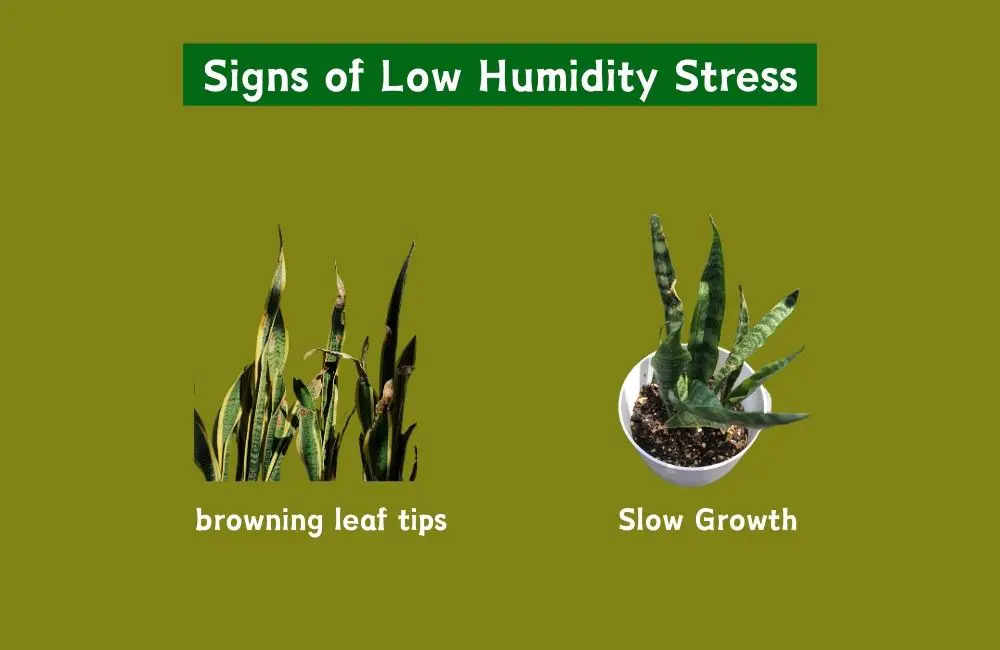
Browning leaf tips and slower growth rates are signs of low humidity stress in snake plants. These symptoms indicate that the plant is not in its ideal growing environment, and adjustments may be needed to improve the surrounding humidity.
This browning is typically not fatal and can be trimmed off to keep the plant looking healthy. Adjusting your plant care routine to increase humidity can help mitigate further stress. This can be as simple as moving your plant to a bathroom with higher moisture levels or using a room humidifier.
Additionally, during the dry winter months, it’s wise to keep snake plants away from direct heat sources like radiators or heating vents. These can exacerbate the dry conditions and increase the likelihood of stress symptoms.
By understanding and managing the humidity needs of your snake plants, you can ensure they thrive and bring life to your indoor spaces, reflecting their natural resilience and low-maintenance nature.
Simple Ways to Increase Humidity
If the air in your home is too dry, especially during winter when heaters are often used, you can use several effective methods to increase humidity levels. This is essential not only for the health of your snake plant but also to prevent the common issue of brown leaf tips and general dryness that can affect its appearance.
Grouping Plants Together

Grouping multiple plants in one area creates a microclimate with higher humidity due to collective transpiration. When plants transpire, they release moisture into the air, which is particularly beneficial in enclosed spaces like apartments where air circulation is limited. This method is not only effective but also enhances the visual appeal of your indoor garden.
If you aim to boost humidity significantly, consider adding various humidity-loving plants alongside your snake plant. Ferns and palms make great companions as they also enjoy and contribute to a moist environment.
To optimize the benefits, ensure there’s enough space between the plants for air to circulate. This prevents excess moisture on the leaves, which can lead to fungal diseases.
Using a Humidity Tray
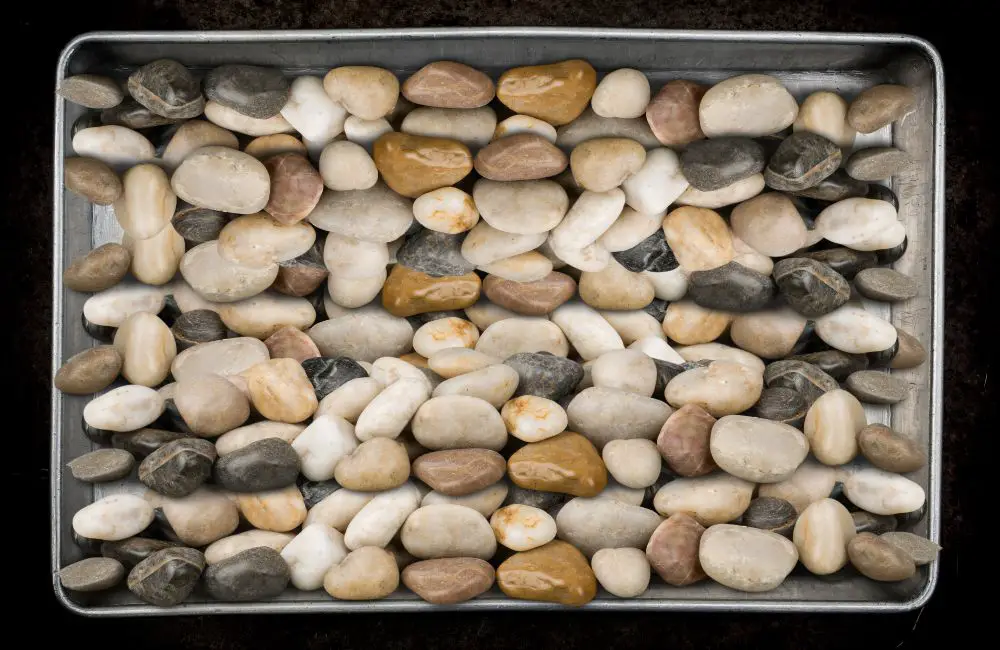
A humidity tray is an easy and economical way to increase the moisture around your plants. Simply fill a shallow tray with pebbles and water, then place your snake plant’s pot on top. The water level should be just below the pebbles to avoid the pot sitting directly in water, which can cause root rot.
As the water evaporates, it naturally increases the humidity around the plant. This method is especially useful in dry climates or during winter when indoor heating can dry out the air. Be sure to refill the tray regularly to maintain a consistent humidity level.
Additionally, placing these trays in strategic locations, such as near sunlight where evaporation is faster, can further enhance their effectiveness.
Regular Misting

Misting your snake plant can quickly raise the humidity around it, mimicking its natural humid environment. It’s best done in the morning so that the moisture can evaporate during the day, reducing the risk of fungal infections.
However, frequent misting is not recommended for all indoor environments as it can contribute to excessive moisture accumulation. It’s crucial to observe your plant’s response to misting and adjust accordingly. If signs of overwatering or fungal growth appear, reduce the misting frequency.
To conclude, maintaining the correct humidity for your snake plant is not difficult. With these simple techniques, you can create an ideal environment that promotes healthy growth and vibrant foliage, ensuring your snake plant thrives in your home.
How to Avoid Excess Humidity
While snake plants do well in moderate humidity, too much moisture in the air can be detrimental, leading to issues such as root rot and fungal diseases. It’s important to maintain a balance that mimics their native arid environment, avoiding overly humid or wet conditions.
Good Air Circulation

Good air circulation is key to preventing excess moisture from settling around your snake plant. Ensure the plant is not crammed in a corner or surrounded by other plants, which can restrict airflow. Using a fan on a low setting nearby can also help circulate air, especially in more humid or stagnant areas of your home.
This improved air movement helps keep the leaves dry and reduces the risk of fungal diseases, which thrive in moist, stagnant conditions. It’s especially important in areas with high humidity or during seasons when homes are kept tightly sealed against cold or heat.
Additionally, regularly dusting the leaves of your snake plant not only keeps the plant looking fresh but also improves its ability to breathe and transpire efficiently, further aiding in humidity management.
Be Careful with Watering

To avoid overwatering your snake plant, check the top inch of soil for dryness before adding water. Due to their drought-tolerant nature, snake plants require less water than many other houseplants. Overwatering can lead to root rot, one of the most common problems with snake plants.
Ensure that the pot has adequate drainage holes to allow any excess water to escape. If your plant lacks drainage, consider repotting it into one that does, or add additional drainage materials like stones or perlite at the bottom of the pot.
During winter, reduce the watering frequency as the plant’s growth slows down and uses less water. This precaution helps prevent soil from remaining soggy, which can be harmful during colder, less sunny periods.
By following these simple steps to manage humidity and watering, you can protect your snake plant from the dangers of too much moisture and ensure it remains healthy and vibrant for years to come.
Final Thoughts
Maintaining the right humidity level for your snake plant is not complicated. With these simple tips, you can ensure your snake plant remains healthy and vibrant, enhancing your indoor space with its sculptural beauty.
Whether you’re a seasoned gardener or a beginner, keeping a snake plant happy is an easy task that rewards you with its resilient nature.
Frequently Asked Questions
The ideal humidity level for snake plants is between 40% to 50% to prevent leaf browning and ensure robust health.
Humidity can be increased for snake plants by using a humidity tray, grouping them with other plants, or misting regularly.
Low humidity stress in snake plants is indicated by brown leaf tips and slowed growth.
Snake plants should have good air circulation to prevent the buildup of excess moisture, which can lead to fungal diseases.
It is recommended to water snake plants every 2-3 weeks, allowing the soil to dry out completely between waterings.
Snake plants are capable of tolerating low humidity, but they thrive best when the humidity is kept at ideal levels.
Excessive humidity can lead to root rot and fungal infections in snake plants.
Overwatering of snake plants can be prevented by ensuring the pot has adequate drainage and the soil dries out between waterings.
Humidity levels around snake plants should be monitored using a hygrometer to ensure they remain within the ideal range.

